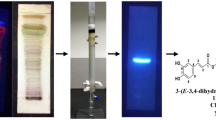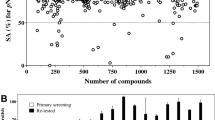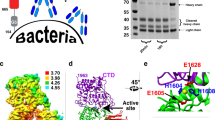Abstract
Thiolutin is a disulfide-containing antibiotic and anti-angiogenic compound produced by Streptomyces. Its biological targets are not known. We show that reduced thiolutin is a zinc chelator that inhibits the JAB1/MPN/Mov34 (JAMM) domain–containing metalloprotease Rpn11, a deubiquitinating enzyme of the 19S proteasome. Thiolutin also inhibits the JAMM metalloproteases Csn5, the deneddylase of the COP9 signalosome; AMSH, which regulates ubiquitin-dependent sorting of cell-surface receptors; and BRCC36, a K63-specific deubiquitinase of the BRCC36-containing isopeptidase complex and the BRCA1–BRCA2-containing complex. We provide evidence that other dithiolopyrrolones also function as inhibitors of JAMM metalloproteases.
This is a preview of subscription content, access via your institution
Access options
Access Nature and 54 other Nature Portfolio journals
Get Nature+, our best-value online-access subscription
$29.99 / 30 days
cancel any time
Subscribe to this journal
Receive 12 print issues and online access
$259.00 per year
only $21.58 per issue
Buy this article
- Purchase on Springer Link
- Instant access to full article PDF
Prices may be subject to local taxes which are calculated during checkout





Similar content being viewed by others
Accession codes
References
Li, B., Wever, W.J., Walsh, C.T. & Bowers, A.A. Dithiolopyrrolones: biosynthesis, synthesis, and activity of a unique class of disulfide-containing antibiotics. Nat. Prod. Rep. 31, 905–923 (2014).
Minamiguchi, K. et al. Thiolutin, an inhibitor of HUVEC adhesion to vitronectin, reduces paxillin in HUVECs and suppresses tumor cell-induced angiogenesis. Int. J. Cancer 93, 307–316 (2001).
Tipper, D.J. Inhibition of yeast ribonucleic acid polymerases by thiolutin. J. Bacteriol. 116, 245–256 (1973).
Jimenez, A., Tipper, D.J. & Davies, J. Mode of action of thiolutin, an inhibitor of macromolecular synthesis in Saccharomyces cerevisiae. Antimicrob. Agents Chemother. 3, 729–738 (1973).
Khachatourians, G.G. & Tipper, D.J. Inhibition of messenger ribonucleic acid synthesis in Escherichia coli by thiolutin. J. Bacteriol. 119, 795–804 (1974).
Grigull, J., Mnaimneh, S., Pootoolal, J., Robinson, M.D. & Hughes, T.R. Genome-wide analysis of mRNA stability using transcription inhibitors and microarrays reveals posttranscriptional control of ribosome biogenesis factors. Mol. Cell. Biol. 24, 5534–5547 (2004).
Pelechano, V. & Pérez-Ortín, J.E. The transcriptional inhibitor thiolutin blocks mRNA degradation in yeast. Yeast 25, 85–92 (2008).
Sivasubramanian, N. & Jayaraman, R. Thiolutin-resistant mutants of Escherichia coli are they RNA chain initiation mutants? Mol. Gen. Genet. 145, 89–96 (1976).
Joshi, A., Verma, M. & Chakravorty, M. Thiolutin-resistant mutants of Salmonella typhimurium. Antimicrob. Agents Chemother. 22, 541–547 (1982).
Roza, J., Blanco, M.G., Hardisson, C. & Salas, J.A. Self-resistance in actinomycetes producing inhibitors of RNA polymerase. J. Antibiot. (Tokyo) 39, 609–612 (1986).
Dai, S. et al. Comprehensive characterization of heat shock protein 27 phosphorylation in human endothelial cells stimulated by the microbial dithiole thiolutin. J. Proteome Res. 7, 4384–4395 (2008).
Jia, Y. et al. Thiolutin inhibits endothelial cell adhesion by perturbing Hsp27 interactions with components of the actin and intermediate filament cytoskeleton. Cell Stress Chaperones 15, 165–181 (2010).
Cope, G.A. et al. Role of predicted metalloprotease motif of Jab1/Csn5 in cleavage of Nedd8 from Cul1. Science 298, 608–611 (2002).
Deshaies, R.J. Proteotoxic crisis, the ubiquitin-proteasome system, and cancer therapy. BMC Biol. 12, 94 (2014).
Cope, G.A. & Deshaies, R.J. Targeted silencing of Jab1/Csn5 in human cells downregulates SCF activity through reduction of F-box protein levels. BMC Biochem. 7, 1 (2006).
Wei, N. & Deng, X.W. The COP9 signalosome. Annu. Rev. Cell Dev. Biol. 19, 261–286 (2003).
Agromayor, M. & Martin-Serrano, J. Interaction of AMSH with ESCRT-III and deubiquitination of endosomal cargo. J. Biol. Chem. 281, 23083–23091 (2006).
McCullough, J., Clague, M.J. & Urbé, S. AMSH is an endosome-associated ubiquitin isopeptidase. J. Cell Biol. 166, 487–492 (2004).
Cooper, E.M. et al. K63-specific deubiquitination by two JAMM/MPN+ complexes: BRISC-associated Brcc36 and proteasomal Poh1. EMBO J. 28, 621–631 (2009).
Sobhian, B. et al. RAP80 targets BRCA1 to specific ubiquitin structures at DNA damage sites. Science 316, 1198–1202 (2007).
Wang, B. et al. Abraxas and RAP80 form a BRCA1 protein complex required for the DNA damage response. Science 316, 1194–1198 (2007).
Zhu, P. et al. A histone H2A deubiquitinase complex coordinating histone acetylation and H1 dissociation in transcriptional regulation. Mol. Cell 27, 609–621 (2007).
Geisberg, J.V., Moqtaderi, Z., Fan, X., Ozsolak, F. & Struhl, K. Global analysis of mRNA isoform half-lives reveals stabilizing and destabilizing elements in yeast. Cell 156, 812–824 (2014).
Dani, C. et al. Extreme instability of myc mRNA in normal and transformed human cells. Proc. Natl. Acad. Sci. USA 81, 7046–7050 (1984).
Cesbron, F., Oehler, M., Ha, N., Sancar, G. & Brunner, M. Transcriptional refractoriness is dependent on core promoter architecture. Nat. Commun. 6, 6753 (2015).
Malzahn, E., Ciprianidis, S., Káldi, K., Schafmeier, T. & Brunner, M. Photoadaptation in Neurospora by competitive interaction of activating and inhibitory LOV domains. Cell 142, 762–772 (2010).
Dai, M.S., Jin, Y., Gallegos, J.R. & Lu, H. Balance of yin and yang: ubiquitylation-mediated regulation of p53 and c-Myc. Neoplasia 8, 630–644 (2006).
Collins, G.A., Gomez, T.A., Deshaies, R.J. & Tansey, W.P. Combined chemical and genetic approach to inhibit proteolysis by the proteasome. Yeast 27, 965–974 (2010).
Verma, R. et al. Role of Rpn11 metalloprotease in deubiquitination and degradation by the 26S proteasome. Science 298, 611–615 (2002).
Perez, C. et al. Discovery of an inhibitor of the proteasome subunit Rpn11. J. Med. Chem. 60, 1343–1361 (2017).
Sato, Y. et al. Structural basis for specific cleavage of Lys63-linked polyubiquitin chains. Nature 455, 358–362 (2008).
Li, J. et al. Capzimin is a potent and specific inhibitor of proteasome isopeptidase Rpn11. Nat. Chem. Biol. 13, 486–493 (2017).
Bonnet, J., Romier, C., Tora, L. & Devys, D. Zinc-finger UBPs: regulators of deubiquitylation. Trends Biochem. Sci. 33, 369–375 (2008).
Wang, H. et al. Role of histone H2A ubiquitination in Polycomb silencing. Nature 431, 873–878 (2004).
Zhou, W., Wang, X. & Rosenfeld, M.G. Histone H2A ubiquitination in transcriptional regulation and DNA damage repair. Int. J. Biochem. Cell Biol. 41, 12–15 (2009).
Cao, R., Tsukada, Y. & Zhang, Y. Role of Bmi-1 and Ring1A in H2A ubiquitylation and Hox gene silencing. Mol. Cell 20, 845–854 (2005).
Belle, J.I. et al. p53 mediates loss of hematopoietic stem cell function and lymphopenia in Mysm1 deficiency. Blood 125, 2344–2348 (2015).
Jiang, X.X. et al. Control of B cell development by the histone H2A deubiquitinase MYSM1. Immunity 35, 883–896 (2011).
Nijnik, A. et al. The critical role of histone H2A-deubiquitinase Mysm1 in hematopoiesis and lymphocyte differentiation. Blood 119, 1370–1379 (2012).
Nandakumar, V., Chou, Y., Zang, L., Huang, X.F. & Chen, S.Y. Epigenetic control of natural killer cell maturation by histone H2A deubiquitinase, MYSM1. Proc. Natl. Acad. Sci. USA 110, E3927–E3936 (2013).
D'Arcy, P., Wang, X. & Linder, S. Deubiquitinase inhibition as a cancer therapeutic strategy. Pharmacol. Ther. 147, 32–54 (2015).
Hideshima, T. et al. Small-molecule inhibition of proteasome and aggresome function induces synergistic antitumor activity in multiple myeloma. Proc. Natl. Acad. Sci. USA 102, 8567–8572 (2005).
Richardson, P.G. et al. Bortezomib or high-dose dexamethasone for relapsed multiple myeloma. N. Engl. J. Med. 352, 2487–2498 (2005).
Diernfellner, A.C., Schafmeier, T., Merrow, M.W. & Brunner, M. Molecular mechanism of temperature sensing by the circadian clock of Neurospora crassa. Genes Dev. 19, 1968–1973 (2005).
Schafmeier, T. et al. Transcriptional feedback of Neurospora circadian clock gene by phosphorylation-dependent inactivation of its transcription factor. Cell 122, 235–246 (2005).
Görl, M. et al. A PEST-like element in FREQUENCY determines the length of the circadian period in Neurospora crassa. EMBO J. 20, 7074–7084 (2001).
Davidson, L., Muniz, L. & West, S. 3′ end formation of pre-mRNA and phosphorylation of Ser2 on the RNA polymerase II CTD are reciprocally coupled in human cells. Genes Dev. 28, 342–356 (2014).
Vera, M. et al. The translation elongation factor eEF1A1 couples transcription to translation during heat shock response. eLife 3, e03164 (2014).
Rose, M.D., Winston, F. & Hieter, P. in Methods in Yeast Genetics—A Laboratory Course Manual. 198 (Cold Spring Harbor Laboratory Press, 1990).
Knop, M. et al. Epitope tagging of yeast genes using a PCR-based strategy: more tags and improved practical routines. Yeast 15, 10B, 963–972 (1999).
Merkl, P. et al. Binding of the termination factor Nsi1 to its cognate DNA site is sufficient to terminate RNA polymerase I transcription in vitro and to induce termination in vivo. Mol. Cell. Biol. 34, 3817–3827 (2014).
Langmead, B., Trapnell, C., Pop, M. & Salzberg, S.L. Ultrafast and memory-efficient alignment of short DNA sequences to the human genome. Genome Biol. 10, R25 (2009).
Schulz, S. et al. Ubiquitin-specific protease-like 1 (USPL1) is a SUMO isopeptidase with essential, non-catalytic functions. EMBO Rep. 13, 930–938 (2012).
Meulmeester, E., Kunze, M., Hsiao, H.H., Urlaub, H. & Melchior, F. Mechanism and consequences for paralog-specific sumoylation of ubiquitin-specific protease 25. Mol. Cell 30, 610–619 (2008).
Worden, E.J., Padovani, C. & Martin, A. Structure of the Rpn11-Rpn8 dimer reveals mechanisms of substrate deubiquitination during proteasomal degradation. Nat. Struct. Mol. Biol. 21, 220–227 (2014).
Duda, D.M. et al. Structural insights into NEDD8 activation of cullin-RING ligases: conformational control of conjugation. Cell 134, 995–1006 (2008).
Zeqiraj, E. et al. Higher-order assembly of BRCC36-KIAA0157 is required for DUB activity and biological function. Mol. Cell 59, 970–983 (2015).
Acknowledgements
We thank T.J. Simpson (University of Bristol) for thiomarinol, S. Cohen (University of California, San Diego) for Zn2+-cyclen, E. Zeqiraj (University of Leeds) for BRISC complex, D. Marzoll (Heidelberg University Biochemistry Center) for purified recombinant Flag-FRQ, A. Martin (University of California, Berkeley) for the pETDuet-1 vector expressing the Rpn11–Rpn8 dimer and M. Knop (ZMBH Heidelberg) for yeast strains. The work was supported by Sonderforschungsbereich 1036 grants to M.B. and F.M., Transregio 186 grant to M.B., Deutsche Forschungsgemeinschaft grant DI1874/1 to A.D. and US National Institutes of Health grant CA164803 to R.J.D. F.M. and M.B. are investigators of Cellnetworks. R.J.D. is an investigator of and was supported by the Howard Hughes Medical Institute.
Author information
Authors and Affiliations
Contributions
A.D. and M.B. designed the research and wrote the manuscript; J.L., Y.Z. and R.J.D. designed, performed and interpreted the Rpn11, Csn5, AMSH and BRCC36 experiments. W.J.W. and A.A.B. synthesized the holothin derivatives. K.P.C. and A.E.P. designed and performed the measurements of intracellular zinc. N.S.-V. and F.M. designed and performed the USP5 and USP25 experiments; P.E.M., S.O. and H.T. designed and performed the Pol I–III in vitro transcription assays. L.L., I.A.C., A.D. and T.S. performed the Neurospora experiments. L.L. and N.H. performed the RNA-seq analysis. L.L. performed the yeast experiments. A.S. and L.L. performed the HeLa experiments. R.J.D. implicated THL as an Rpn11 inhibitor and edited the manuscript.
Corresponding authors
Ethics declarations
Competing interests
R.J.D. is a founder, shareholder, member of the scientific advisory board and consultant of Cleave Biosciences, which is developing drugs that target protein homeostasis in cancer.
Supplementary information
Supplementary Text and Figures
Supplementary Results, Supplementary Table 1 and Supplementary Figures 1–10 (PDF 14892 kb)
Supplementary Note
Synthesis and Characterization of Chemical Compounds (PDF 617 kb)
Rights and permissions
About this article
Cite this article
Lauinger, L., Li, J., Shostak, A. et al. Thiolutin is a zinc chelator that inhibits the Rpn11 and other JAMM metalloproteases. Nat Chem Biol 13, 709–714 (2017). https://doi.org/10.1038/nchembio.2370
Received:
Accepted:
Published:
Issue Date:
DOI: https://doi.org/10.1038/nchembio.2370
This article is cited by
-
Regulatory mechanisms and therapeutic potential of JAB1 in neurological development and disorders
Molecular Medicine (2023)
-
Genetic deletion and pharmacologic inhibition of E3 ubiquitin ligase HOIP impairs the propagation of myeloid leukemia
Leukemia (2023)
-
Thiolutin attenuates ischemic stroke injury via inhibition of NLRP3 inflammasome: an in vitro and in vivo study
Experimental Brain Research (2023)
-
BRISC is required for optimal activation of NF-κB in Kupffer cells induced by LPS and contributes to acute liver injury
Cell Death & Disease (2023)
-
Light regulates the degradation of the regulatory protein VE-1 in the fungus Neurospora crassa
BMC Biology (2022)



